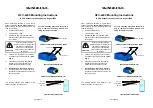Summary of Contents for Nimblegen MS 200
Page 1: ......
Page 2: ......
Page 22: ...10 NimbleGen MS 200 Microarray Scanner Operator s Manual v1 0 Notes ...
Page 42: ...30 NimbleGen MS 200 Microarray Scanner Operator s Manual v1 0 Notes ...
Page 84: ...72 NimbleGen MS 200 Microarray Scanner Operator s Manual v1 0 Notes ...
Page 95: ...NimbleGen MS 200 Microarray Scanner Operator s Manual v1 0 83 ...
Page 103: ......



































